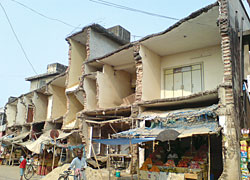 |
The eastern section of Jaleshwar is the seat of temporal authority. Almost all government offices are located along a north-south road that connects the army barracks with the CDO office. The district hospital and schools too are in this area for the convenience of the families of public servants. Increasingly, however, government officials are to be found in Janakpur, from where they commute everyday.
The bajar area links these two parts and is the belly of the town, almost literally, as it houses all the main eateries, mithai shops, beer bars and arrack outlets. This is where journalists gather in the evening, politicians hold court in front of paan shops and manpower agents try to lure unsuspecting villagers into low-paying jobs in Afghanistan and Iraq. But the Chowk no longer glitters. With the en masse departure of the Marwari shopkeepers, shopping is not the attraction it used to be.
There are economic reasons behind the out-migration of this vibrant business community. Janakpur has emerged as a bigger commercial centre and attracts traders from smaller towns in the vicinity. Enterprising traders have moved as far as Birganj and Lahan, and some have even moved to the capital to make their fortunes. But the most important factor behind the flight of Jaleshwar's Marwaris is psychological.
A half-dismantled shopping centre in the bajar (see box) stands as a monument to the humiliation of the most respected Marwari trader in town at the hands of an arriviste UML politico. Perhaps to remind locals of their complicity in the crime as bemused bystanders, the owners of the once-magnificent house have left the skeleton intact.
When it was built in the late eighties, Siriya Marwari's house looked too imposing to be in a town as sleepy as Jaleshwar. But the venerable Seth wanted to impress local government officers with his wealth, taste and power. Engineers and builders were brought in from Mujaffarpur and construction material was procured from Kathmandu and Patna. The top floor of the building was to house his family while businesses were to operate from shuttered fronts on the ground floor. For the first few years, it appeared as if the town finally had a commercial landmark. But jealousy is the evil twin of success.
After the political changes of 1990, the old Seth found it hard to learn new tricks to do business with the UML upstarts in town. Mayor Balkrishna Dhakal used his proximity to Khadga Oli and Madhav Nepal to push through demolition orders, ostensibly to widen a road where few buses ply even today. The building was defaced and rendered unusable. Unable to bear the humiliation, the most well-known Marwari family of Mahottari left Jaleshwar for good.
With the big businesses gone, the town wears a somewhat dehydrated look. Other than government vehicles, there are few cars to use the recently widened and freshly paved roads. Unsure of the variety and quality of locally available goods, shoppers prefer to go to Janakpur for bigger purchases. Local temples have few patrons and schools and colleges routinely fail to raise funds for additional infrastructure. The Maoists are the new UML around town, with former revolutionaries such as Mayor Dhakal settled into comfortable bourgeois life.
For politicians looking for cheap popularity, eminent domain (the right of the state to take private property for public use) is a useful tool, and one that makes the rich quaver. The right to property, however, is the sine qua non of economic development. Jaleshwar's sad story bears testament to a clash in which the state won the battle, but everyone lost the war.



